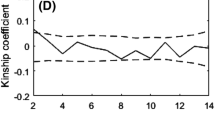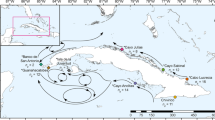Abstract
Correct identification of closely related species is important for reliable measures of gene flow. Incorrectly lumping individuals of different species together has been shown to over- or underestimate population differentiation, but examples highlighting when these different results are observed in empirical datasets are rare. Using 199 single nucleotide polymorphisms, we assigned 768 individuals in the Acropora hyacinthus and A. cytherea morphospecies complexes to each of eight previously identified cryptic genetic species and measured intraspecific genetic differentiation across three geographic scales (within reefs, among reefs within an archipelago, and among Pacific archipelagos). We then compared these calculations to estimated genetic differentiation at each scale with all cryptic genetic species mixed as if we could not tell them apart. At the reef scale, correct genetic species identification yielded lower FST estimates and fewer significant comparisons than when species were mixed, raising estimates of short-scale gene flow. In contrast, correct genetic species identification at large spatial scales yielded higher FST measurements than mixed-species comparisons, lowering estimates of long-term gene flow among archipelagos. A meta-analysis of published population genetic studies in corals found similar results: FST estimates at small spatial scales were lower and significance was found less often in studies that controlled for cryptic species. Our results and these prior datasets controlling for cryptic species suggest that genetic differentiation among local reefs may be lower than what has generally been reported in the literature. Not properly controlling for cryptic species structure can bias population genetic analyses in different directions across spatial scales, and this has important implications for conservation strategies that rely on these estimates.



Similar content being viewed by others
References
Anderson EC, Garza JC (2006) The power of single-nucleotide polymorphisms for large-scale parentage inference. Genetics 172:2567–2582
Ayre DJ, Hughes TP (2000) Genotypic diversity and gene flow in brooding and spawning corals along the Great Barrier Reef, Australia. Evolution 54:1590–1605
Baums IB, Miller MW, Hellberg ME (2005) Regionally isolated populations of an imperiled Caribbean coral, Acropora palmata. Molecular Ecology 14:1377–1390
Bay RA, Rose NH, Logan C, Palumbi SR (2018) Genomic models predict successful coral adaptation if future ocean warming rates are reduced. Science Advances 3:e1701413
Budd AF, Fukami H, Smith ND, Knowlton N (2012) Taxonomic classification of the reef coral family Mussidae (Cnidaria: Anthozoa: Scleractinia). Zoological Journal of the Linnaean Society 166:465–529
Cros A, Toonen RJ, Davies SW, Karl SA (2016) Population genetic structure between Yap and Palau for the coral Acropora hyacinthus. PeerJ 4:e2330
Earl DA, vonHoldt BM (2011) STRUCTURE HARVESTER: a website and program for visualizing STRUCTURE output and implementing the Evanno method. Conservation Genetics Resources 4:359–361
Forsman ZH, Concepcion GT, Haverkort RD, Shaw RW, Maragos JE, Toonen RJ (2010) Ecomorph or endangered coral? DNA and Microstructure reveal Hawaiian species complexes: Montipora dilatata/flabellata/turgescens & M. patula/verrilli. PLoS ONE 5:e15021
Gélin P, Fauvelot C, Mehn V, Bureau S, Rouzé H, Magalon H (2017) Superclone expansion, long-distance clonal dispersal and local genetic structuring in the coral Pocillopora damicornis Type β in Reunion Island. South Western Indian Ocean. PLoS ONE 12:e0169692
Hare MP, Palumbi SR (2002) Genetic distinctiveness of inshore and offshore Spisula clams. Journal of Shellfish Research 21:381
Hastings A, Botsford LW (2006) Persistence of spatial populations depends on returning home. PNAS 13:6067–6072
Hoegh-Guldberg O, Mumby PJ, Hooten AJ, Steneck RS, Greenfield P, Gomez E, Harvell CD, Sale PF, Edwards AJ, Caldeira K, Knowlton N, Eakin CM, Iglesias-Prieto R, Muthiga N, Bradbury RH, Dubi A, Hatziolos ME (2007) Coral reefs under rapid climate change and ocean acidification. Science 318:1737–1742
Hughes TP, Baird AH, Bellwood DR, Card M, Connolly SR, Folke C, Grosberg R, Hoegh-Guldberg O, Jackson JBC, Kleypas J, Lough JM, Marshall P, Nyström M, Palumbi SR, Pandolfi JM, Rosen B, Roughgarden J (2003) Climate change, human impacts, and the resilience of coral reefs. Science 301:929–933
Kinlan BP, Gaines SD, Lester SE (2005) Propagule dispersal and the scales of marine community process. Diversity and Distributions 11:139–148
Knowlton N (2000) Molecular genetic analyses of species boundaries in the sea. Hydrobiologia 420:73–90
Knowlton N, Weil E, Weigt LA, Guzmán HM (1992) Sibling species in Montastraea annularis, coral bleaching, and the coral climate record. Science 255:330–333
Ladner JT, Palumbi SR (2012) Extensive sympatry, cryptic diversity and introgression throughout the geographic distribution of two coral species complexes. Molecular Ecology 21:2224–2238
Levitan DR, Fukami H, Jara J, Kline D, McGovern TM, McGhee KE, Swanson CA, Knowlton N (2004) Mechanisms of reproductive isolation among sympatric broadcast-spawning corals of the Montasraea annularis species complex. Evolution 58:308–323
Magalon H, Adjeroud M, Veuille M (2005) Patterns of genetic variation do not correlate with geographical distance in the reef-building coral Pocillopora meandrina in the South Pacific. Molecular Ecology 14:1861–1868
Mallet J (1995) A species definition for the modern synthesis. Trends in Ecology and Evolution 10:294–299
Ottman D, Grorud-Colvert K, Sard NM, Huntington BE, Banks MA, Sponaugle S (2016) Long-term aggregation of larval fish siblings during dispersal along an open coast. PNAS 113:14067–14072
Paetkau D, Slade R, Burden M, Estoup A (2004) Genetic assignment methods for the direct, real-time estimation of migration rate: a simulation-based exploration of accuracy and power. Molecular Ecology 13:55–65
Palumbi SR (1994) Genetic divergence, reproductive isolation, and marine speciation. Annu. Rev. Ecol. Sys. 25:547–572
Palumbi SR (2003) Population genetics, demographic connectivity, and the design of marine reserves. Ecological Applications 13:S146–S158
Palumbi SR, Vollmer S, Romano S, Oliver T, Ladner J (2011) The role of genes in understanding the evolutionary ecology of reef building corals. Evolutionary Ecology 26:317–335
Pante E, Puillandre N, Viricel A, Arnaud-Haond S, Aurelle D, Castelin M, Chenuil A, Destombe C, Forcioli D, Valero M, Viard F, Samadi S (2015) Species are hypotheses: avoid connectivity assessments based on pillars of sand. Molecular Ecology 24:525–544
Paz-García DA, Chávez-Romo HE, Correa-Sandoval F et al (2012) Genetic connectivity patterns of corals Pocillopra damicornis and Porites panamensis (Anthozoa: Scleractinia) along the west coast of Mexico. Pacific Science 661:43–61
Peakall R, Smouse PE (2012) GenAlEx 6.5: genetic analysis in Excel. Population genetic software for teaching and research–an update. Bioinformatics 28:2537–2539
Pfenninger M, Schwenk K (2007) Cryptic animal species are homogeneously distributed among taxa and biogeographical regions. BMC Evolutionary Biology 7:121
Pritchard JK, Stephens M, Donnelly P (2000) Inference of population structure using multilocus genotype data. Genetics 155:945–959
Richards ZT, Berry O, Oppen MJH (2016) Cryptic genetic divergence within threatened species of Acropora coral from the Indian and Pacific Oceans. Conservation Genetics 17:577–591
Rose NH, Bay RA, Morikawa MK, Palumbi SR (2018) Polygenic evolution drives species divergence and climate adaptation in corals. Evolution 72:82–94
Rousset F (2008) GENEPOP’007: a complete re-implementation of the GENEPOP software for Windows and Linux. Molecular Ecology Resources 8:103–106
Shearer TL, Coffroth MA (2008) Barcoding corals: limited by interspecific divergence, not intraspecific variation. Molecular Ecology Resources 8:247–255
Slatkin M (1987) Gene flow and the geographic structure of natural populations. Science 236:787–792
Souter P (2009) Hidden genetic diversity in a key model species of coral. Marine Biology 157:875–885
Suzuki G, Keshavmurthy S, Hayashibara T, Wallace CC, Shirayama Y, Chen CA, Fukami H (2016) Genetic evidence of peripheral isolation and low diversity in marginal populations of the Acropora hyacinthus complex. Coral Reefs 35:1419–1432
Tigano A, Friesen VL (2016) Genomics of local adaptation with gene flow. Molecular Ecology 25:2144–2164
Van Oppen MJH, Willis BL, Rheede TV, Miller DJ (2002) Spawning times, reproductive compatibilities and genetic structuring in the Acropora aspera group: evidence for natural hybridization and semi-permeable species boundaries in corals. Molecular Ecology 11:1363–1376
Van Oppen MJH, Peplow LM, Kinimonth S, Berkelmans R (2011) Historical and contemporary factors shape the population genetic structure of the broadcast spawning coral, Acropora millepora, on the Great Barrier Reef. Molecular Ecology 20:4899–4914
Veron J (2000) Corals of the World. Australian Institute of Marine Science, Townsville, Queensland
Vollmer SV, Palumbi SR (2002) Hybridization and the Evolution of Reef Coral Diversity. Science 296:2023–2025
Vollmer SV, Palumbi SR (2006) Restricted Gene Flow in the Caribbean Staghorn Coral Acropora cervicornis: Implications for the Recovery of Endangered Reefs. Journal of Heredity 98:40–50
Wahlund S (1928) Zusammensetzung von Population und Korrelationserscheinung vom Standpunkt der Vererbungslehre aus betrachtet. Hereditas 11:65–106
Wallace CC (1999) Staghorn Corals of the World: A revision of the Coral Genus Acropora (Scleractinia; Astrocoeniina; Acroporidae) Worldwide, with Emphasis on Morphology. Phylogeny and Biogeography, CSIRO, Collingwood, Victoria
Williamson DH, Harrison HB, Almany GR, Berumen ML, Bode M, Bonin MC, Bonin M, Choukroun S, Doherty PJ, Frisch AJ, Saenz-Agudelo P, Jones GP (2016) Large-scale, multidirectional connectivity among coral reef populations in the Great Barrier Reef Marine Park. Molecular Ecology 25:6039–6054
Warner PA, van Oppen MJH, Willis BL (2015) Unexpected cryptic species diversity in the widespread coral Seriatopora hystrixmasks spatial-genetic patterns of connectivity. Molecular Ecology 24:2993–3008
Wham DC, LaJeunesse TC (2016) Symbiodinium population genetics: testing for species boundaries and analysing samples with mixed genotypes. Molecular Ecology 25:2699–2712
Wilson K, Li YT, Whan V, Lehnert S, Byrne K, Moore S, Pongsomboon S, Tassanakajon A, Rosenberg G, Ballment E, Fayazi Z, Swan J, Kenway M, Benzie J (2002) Genetic mapping of the black tiger shrimp Penaeus monodon with amplified fragment length polymorphism. Aquaculture 204:297–309
Acknowledgements
This study was conducted over many years—from sample collection to initial discovery of cryptic species to a focus on expanded sample sizes—and as a result was improved by many people while they were in the SRP lab, including Jason Ladner, Kelly Barr, Hannah Jaris, and Deborah Johnson. Dan Griffin helped in much of the sample collection. This Project was funded through Grants to S.R.P. from the Gordon and Betty Moore Foundation and the National Science Foundation (RAPID-1547921), as well as support from the Stanford University Office of International Affairs, Stanford University Bio-X, the US National Park Service, Conservation International, and the Palau International Coral Reef Center.
Data availability
Reference DNA sequences for seven exons and one mt control region locus. SNP genotypes for each individual along with sample location and cryptic genetic species identification: Stanford Digital Repository https://purl.stanford.edu/dr174rj9968.
Author information
Authors and Affiliations
Corresponding author
Additional information
Topic Editor Dr. Line K. Bay
Electronic supplementary material
Below is the link to the electronic supplementary material.
Rights and permissions
About this article
Cite this article
Sheets, E.A., Warner, P.A. & Palumbi, S.R. Accurate population genetic measurements require cryptic species identification in corals. Coral Reefs 37, 549–563 (2018). https://doi.org/10.1007/s00338-018-1679-9
Received:
Accepted:
Published:
Issue Date:
DOI: https://doi.org/10.1007/s00338-018-1679-9




